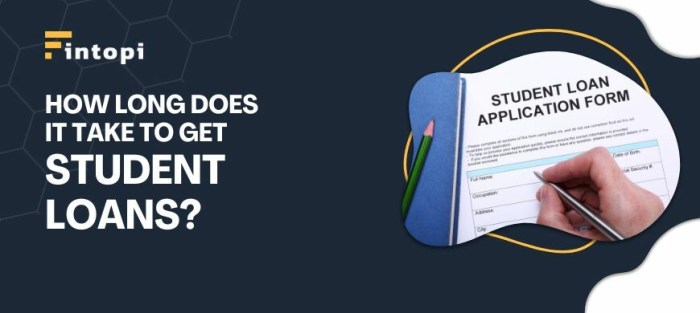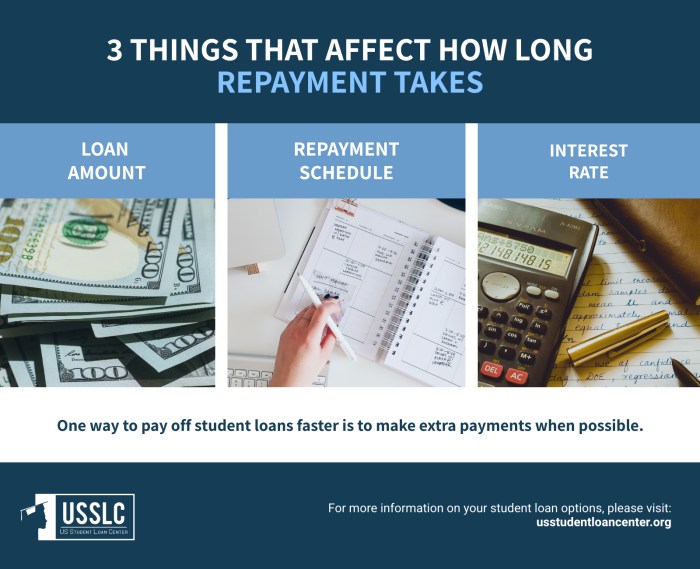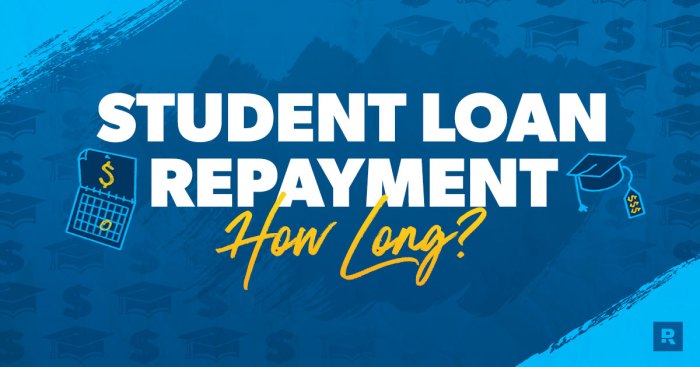
Navigating the complexities of student loan repayment can feel overwhelming. The journey to becoming debt-free hinges on several interconnected factors, from the type of loan you hold to the repayment plan you choose. Understanding these variables is crucial for developing a realistic repayment strategy and achieving financial freedom sooner.
This guide explores the various aspects influencing student loan repayment timelines, providing a clear understanding of the factors involved and offering strategies to potentially accelerate your progress. We’ll examine standard and income-driven repayment plans, highlight the impact of interest rates and loan amounts, and discuss methods for reducing your repayment period. By the end, you’ll have a better grasp of how long your repayment journey might be and how to potentially shorten it.
Factors Influencing Student Loan Repayment Time
The length of time it takes to repay student loans is highly variable, depending on several interconnected factors. Understanding these factors is crucial for borrowers to develop a realistic repayment strategy and avoid potential financial strain. This section will explore the key elements that influence how long your student loan repayment journey will last.
Loan Type and Repayment Duration
The type of federal student loan significantly impacts repayment. Subsidized loans don’t accrue interest while you’re in school (at least under certain eligibility conditions) or during grace periods, potentially shortening the repayment period compared to unsubsidized loans, which accrue interest from disbursement. PLUS loans, typically taken out by parents or graduate students, often have higher interest rates and potentially longer repayment terms, leading to a longer repayment timeline. Private student loans also vary widely in terms and conditions, impacting repayment duration.
Interest Rates and Repayment Timeline
Higher interest rates dramatically increase the total amount you’ll pay over the life of the loan and, consequently, extend the repayment period. Even a small difference in interest rates can lead to substantial differences in total cost and repayment time. For example, a loan with a 5% interest rate will be paid off faster than a loan with a 7% interest rate, assuming all other factors remain constant. Careful consideration of interest rates is essential when selecting a loan and repayment plan.
Repayment Plan Options and Repayment Schedules
Several repayment plans are available, each affecting the repayment schedule and overall duration. The standard repayment plan typically involves fixed monthly payments over 10 years. Extended repayment plans can stretch payments over a longer period (up to 25 years for some loans), lowering monthly payments but increasing the total interest paid and overall repayment time. Income-driven repayment plans (IDR) tie monthly payments to your income and family size, potentially resulting in lower monthly payments and longer repayment periods, sometimes up to 20 or 25 years. The choice of repayment plan significantly impacts the length of repayment.
Loan Consolidation and Repayment Time
Consolidating multiple student loans into a single loan can simplify repayment by combining various interest rates and monthly payments into one manageable payment. However, the impact on repayment time is complex. While it streamlines the process, the new loan’s interest rate is often a weighted average of the original loans’ rates. This might lead to a slightly longer repayment period if the weighted average rate is higher than the lowest rate among the original loans. Conversely, if a borrower chooses a longer repayment term with consolidation, this will increase the total repayment time.
Repayment Timelines: A Sample Comparison
The following table illustrates how loan amount and interest rate influence repayment timelines under a standard 10-year repayment plan. Note that these are simplified examples and do not include fees or other potential charges.
| Loan Amount | Interest Rate | Approximate Monthly Payment | Total Repayment Time |
|---|---|---|---|
| $20,000 | 5% | $212 | 10 years |
| $30,000 | 5% | $318 | 10 years |
| $20,000 | 7% | $222 | 10 years |
| $30,000 | 7% | $333 | 10 years |
Standard Repayment Plans and Their Durations

Understanding standard repayment plans is crucial for effectively managing student loan debt. These plans offer a structured approach to repayment, typically involving fixed monthly payments over a set period. However, the specific terms and duration can vary based on the loan amount and interest rate.
The typical repayment period for a standard repayment plan is 10 years (120 months). This timeframe is designed to allow borrowers to gradually repay their loans while maintaining manageable monthly payments. It’s important to remember that the longer the repayment period, the more interest you’ll pay overall. Conversely, shorter repayment periods result in higher monthly payments but lower total interest paid.
Standard Repayment Plan Examples
The following examples illustrate how loan amount and interest rate influence monthly payments and repayment duration under a standard 10-year plan. These are simplified examples and do not include factors like fees or potential changes in interest rates. Actual repayment amounts may vary depending on the lender and specific loan terms.
- Scenario 1: Loan Amount: $20,000; Interest Rate: 5%; Repayment Duration: 10 years (120 months); Approximate Monthly Payment: $212
- Scenario 2: Loan Amount: $30,000; Interest Rate: 6%; Repayment Duration: 10 years (120 months); Approximate Monthly Payment: $327
- Scenario 3: Loan Amount: $40,000; Interest Rate: 7%; Repayment Duration: 10 years (120 months); Approximate Monthly Payment: $442
- Scenario 4: Loan Amount: $50,000; Interest Rate: 8%; Repayment Duration: 10 years (120 months); Approximate Monthly Payment: $557
It is important to note that these are estimates. The actual monthly payment will depend on the specific terms of your loan agreement and may vary slightly. Contact your loan servicer for precise calculations based on your individual loan details. Careful budgeting and financial planning are essential to ensure timely and successful repayment.
Income-Driven Repayment Plans

Income-driven repayment (IDR) plans offer a flexible approach to student loan repayment, tailoring monthly payments to your income and family size. This can significantly impact your overall repayment timeline, potentially extending it but also lowering your monthly burden. Understanding the nuances of each plan is crucial for making an informed decision.
Income-Driven Repayment Plan Comparison
Several federal IDR plans exist, each with its own eligibility criteria, payment calculation method, and potential impact on loan forgiveness. These plans include Income-Based Repayment (IBR), Pay As You Earn (PAYE), Revised Pay As You Earn (REPAYE), and Income-Contingent Repayment (ICR). While they share the common goal of making repayment more manageable, key differences exist.
Eligibility Requirements for Income-Driven Repayment Plans
Eligibility for IDR plans generally requires having federal student loans (excluding Parent PLUS loans for PAYE and REPAYE), completing an income-driven repayment application, and demonstrating financial need based on your income and family size. Specific requirements may vary slightly depending on the chosen plan and the type of loans held. For example, some plans might have income thresholds or require a specific type of loan.
Benefits and Drawbacks of Income-Driven Repayment Plans: Repayment Time
A major benefit of IDR plans is the potential for lower monthly payments, making repayment more affordable in the short term. However, this often comes at the cost of a longer repayment period, potentially extending the repayment time to 20 or 25 years, or even leading to loan forgiveness after a specified period. The extended repayment period means you’ll pay more in interest over the life of the loan. Careful consideration of the long-term implications, including the total interest paid, is essential.
Sample Borrower Repayment Comparison Across IDR Plans
The following table illustrates potential differences in monthly payments and total repayment time across different IDR plans for a hypothetical borrower with $50,000 in federal student loans, an annual income of $40,000, and a family size of one. These figures are illustrative and actual payments will vary based on individual circumstances and the specific terms of each plan. Note that this is a simplified example and does not include all possible factors influencing repayment.
| Plan | Estimated Monthly Payment | Estimated Total Repayment Time (Years) | Estimated Total Interest Paid |
|---|---|---|---|
| IBR | $250 | 25 | $30,000 |
| PAYE | $200 | 20 | $25,000 |
| REPAYE | $225 | 22 | $27,000 |
| ICR | $275 | 25 | $32,000 |
Strategies to Accelerate Repayment
Paying off student loans faster can significantly reduce the overall cost and free up your finances sooner. Several strategies can help you achieve this goal, focusing on increasing payments, strategically managing your loans, and improving your financial habits. These methods, when implemented effectively, can lead to substantial savings and a quicker path to financial freedom.
Making Extra Payments
Accelerating your repayment involves making payments beyond your scheduled monthly amount. Even small additional payments can have a considerable long-term impact. For example, consider making one extra payment per year; this can shorten your repayment timeline considerably. Alternatively, you could allocate a portion of any unexpected income, such as a tax refund or bonus, directly towards your student loans. Another effective approach is to round up your monthly payment to the nearest hundred or even fifty dollars. While seemingly insignificant individually, these extra amounts compound over time, leading to faster debt reduction. For instance, an extra $50 per month on a $500 monthly payment might seem small, but over 10 years, that adds up to a significant reduction in principal.
Refinancing Student Loans
Refinancing involves replacing your existing student loans with a new loan from a different lender, often at a lower interest rate. A lower interest rate directly translates to less interest paid over the life of the loan and can significantly reduce your repayment time, even if the loan term remains the same. For example, if you refinance a $30,000 loan from 7% to 5%, you’ll save thousands of dollars in interest and potentially pay off the loan years earlier. However, it’s crucial to carefully compare offers from multiple lenders to secure the best possible terms and ensure that refinancing aligns with your overall financial goals. Consider the fees associated with refinancing and whether the long-term savings outweigh any upfront costs.
Bi-Weekly Payments
Making bi-weekly payments instead of monthly payments is a simple yet effective strategy. While seemingly minor, this method equates to making an extra monthly payment each year. By dividing your monthly payment by two and paying that amount every two weeks, you essentially make 13 payments annually instead of 12. This strategy leverages the power of compounding interest to your advantage, leading to a faster payoff. For instance, if your monthly payment is $300, a bi-weekly payment of $150 will result in an extra $300 payment annually, considerably accelerating the repayment process.
Budgeting and Financial Planning
A well-structured budget is essential for accelerating loan repayment. By carefully tracking income and expenses, you can identify areas where you can cut back and allocate more funds towards your student loans. Financial planning goes hand-in-hand with budgeting, enabling you to create a realistic plan that Artikels your short-term and long-term financial goals, including student loan repayment. This might involve creating a detailed repayment schedule, setting savings goals to make larger lump-sum payments, and prioritizing debt reduction over other financial goals. For example, carefully tracking expenses might reveal unnecessary subscriptions or entertainment costs that can be reduced to free up additional funds for loan payments. A detailed financial plan helps ensure you remain on track and achieve your repayment goals.
Visual Representation of Repayment Timelines
Understanding the visual representation of student loan repayment is crucial for effective financial planning. Different repayment plans significantly alter the total repayment time and the overall interest paid. A clear visualization helps borrowers compare options and make informed decisions.
A hypothetical scenario illustrates this effectively. Let’s consider Sarah, who has a $50,000 student loan with a 6% interest rate. We’ll examine her repayment timeline under three different plans: Standard, Income-Driven (IDR), and Accelerated.
Repayment Timeline Comparison for a $50,000 Loan
The following table illustrates a comparison of Sarah’s repayment under three different scenarios. These figures are simplified examples and actual repayment amounts may vary based on specific loan terms and individual circumstances.
| Repayment Plan | Monthly Payment | Repayment Period (Years) | Total Interest Paid |
|---|---|---|---|
| Standard (10-year) | $550 | 10 | $16,000 |
| Income-Driven (20-year) | $300 (assuming lower monthly payment due to income) | 20 | $26,000 |
| Accelerated (5-year) | $1,000 | 5 | $6,000 |
Graphical Representation of Repayment Strategies
Imagine a bar graph. The horizontal axis represents the different repayment plans: Standard, Income-Driven, and Accelerated. The vertical axis represents the total repayment time in years.
The Standard plan would be represented by a bar reaching 10 years on the vertical axis. The Income-Driven plan would have a significantly longer bar, extending to 20 years. Finally, the Accelerated plan would show a much shorter bar, reaching only 5 years. A second bar graph, using the same horizontal axis, could depict the total interest paid under each plan. This graph would show the shortest bar for the Accelerated plan (representing the lowest interest paid), followed by the Standard plan, and finally, the longest bar for the Income-Driven plan, reflecting the highest total interest paid. This visual comparison clearly demonstrates the trade-off between repayment time and total interest paid. A shorter repayment period generally results in less interest paid, but requires higher monthly payments. Conversely, a longer repayment period reduces monthly payments, but results in higher total interest costs.
Ending Remarks

Successfully managing student loan repayment requires careful planning and a proactive approach. While the exact repayment timeline varies greatly depending on individual circumstances, understanding the factors at play—loan type, interest rates, repayment plans, and personal financial strategies—empowers you to make informed decisions. By utilizing the information and strategies Artikeld here, you can create a tailored repayment plan that aligns with your financial goals and sets you on the path towards a debt-free future.
User Queries
What happens if I miss a student loan payment?
Missing payments can result in late fees, damage your credit score, and potentially lead to loan default. Contact your loan servicer immediately if you anticipate difficulty making a payment.
Can I pay off my student loans early without penalty?
Generally, you can pay off your student loans early without penalty. This can save you money on interest in the long run.
How often can I make extra payments towards my student loans?
Most lenders allow extra payments as frequently as you wish. Some even have online portals to make this process easier.
What if my income changes significantly after starting a repayment plan?
If your income changes substantially, you may be eligible to adjust your repayment plan. Contact your loan servicer to explore your options.
